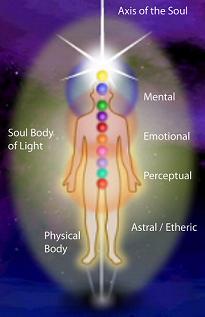by John White
When our research took us into the mind-stretching realms of the highest yogic attainment, we were happy to be able to rely on our dear friend and fellow dharma naut John White for guidance. White, intrepid explorer and tireless documenter of the highest in human potential, has written extensively about an evolutionary shift in consciousness that he sees transforming humanity. Here, he provides us with a brief retrospective survey, through history, and across traditions, of what some believe to be our evolutionary destiny—the attainment of “the light body.”
ENLIGHTENMENT IS THE goal of human life, for the individual and for the race. Enlightenment is awakening to the presence of God as the One-in-all and All-in-one and then expressing that nondual realization in every aspect of your existence. Simply put, enlightenment is God-realization, i.e., making God real in the totality of your being.
Enlightenment, therefore, is a developmental process, not a one-time event. It is the highest aspect of our human potential for self-directed growth in body, mind, and spirit. That human potential can change the human condition.
Enlightenment is not purely psychological. In the course of higher human development, physical changes also occur, most dramatically in the later phases of the enlightenment process. In the final phase, according to various sacred traditions, the body is alchemically changed into light.
Enlightenment becomes literally so, through the transubstantiation of flesh, blood, and bone into an immortal body of light. Through a combination of personal effort and divine grace, a person attains a deathless condition through the alchemical transmutation of his or her ordinary fleshly body. This transubstantiated body is called various names in the traditions, such as light body, solar body, the diamond body, or resurrection body. I’ll expand on that below.
If involution is the materialization of Spirit and evolution is the spiritualization of matter, then the end of evolution ”final enlightenment” is the complete return of matter to Spirit as humans attain the full expression of their inherent divinity and become Godmen and God Women. It is the conquest of death. It is the return to the condition of “that which never dies and that which was never born.”
From Morality to Mysticism
Morality, or the moral dimension of life, is the foundation for the process of higher human development to enlightenment. However, the process only begins there. As a person practices spiritual disciplines ”prayer, meditation, or esoteric psychotechnologies” to deepen his or her relationship with God, the person ascends in consciousness to higher and higher planes of existence. Mystical experience and arcane metaphysics come to the forefront of the person’s consciousness, and the light of God shines ever more brightly through every aspect of the person’s life. Ultimately, the quest for enlightenment leads one to actually becoming light” attaining the body of light and becoming a being of light. Morality and virtue are then understood to be the human reflection of divine attributes, and the practice of mysticism is understood as a process of becoming, quite literally, more and more Godlike.
The important thing in the process is, as the Bhagavad Gita puts it, to “fix your heart on God, ” submit your will to the Divine Will, and then invoke the Holy Spirit, the Shekinah Glory, the Goddess Kundalini, etcetera, as the entry point for your spiritual practice. The support that with moral behavior, cultivation of the body and mind, works of social goodness, and civic responsibility. In other words, live a life of integral practice, so that your entire being “body, mind, and spirit” is oriented to the attainment of enlightenment. God will take care of the rest. Through spiritual refinement, the psychophysical dross of your humanity is removed. Then you can “cast off ” the flesh body through the death process. You put on the “seamless robe of light. ” You no longer cast a shadow because you do not have a Shadow.
Sacred Traditions for Higher Human Development
- If there is an inner unity or transcendent common core to world religions and sacred traditions, we should expect that the human potential for transubstantiation would be understood by all of them. Indeed, that is just what we find. Some of the names given to the body of light are as follows:
- In the Judeo-Christian tradition, it is called “the resurrection body ” and “the glorified body.” The prophet Isaiah said, “The dead shall live, their bodies shall rise” (Isa. 26:19). St. Paul called it “the celestial body” or “spiritual body ” (soma pneumatikon) (I Corinthians 15:40).
- In Sufism, it is called “the most sacred body ” (wujud al-aqdas) and “supra celestial body ” (jism asli haqiqi).
- In Taoism, it is called “the diamond body,” and those who have attained it are called “the immortals” and “the cloud walkers.”
- In Tibetan Buddhism, it is called “the light body.”
- In Tantrism and some schools of yoga, it is called “the vajra body,” “the adamantine body,” and “the divine body.”
- In Kriya yoga, it is called “the body of bliss.”
- In Vedanta, it is called “the superconductive body.”
- In Gnosticism and Neoplatonism, it is called “the radiant body.”
- In the alchemical tradition, the Emerald Tablet calls it “the Glory of the Whole Universe” and “the golden body.” The alchemist Paracelsus called it “the astral body.”
- In the Hermetic Corpus, it is called “the immortal body ” (soma athanaton).
- In some mystery schools, it is called “the solar body.”
- In Rosicrucianism, it is called “the diamond body of the temple of God.”
- In ancient Egypt, it was called “the luminous body or being” (akh).
- In Old Persia, it was called “the indwelling divine potential” (fravashi or fravarti).
- In the Mithraic liturgy, it was called “the perfect body ” (soma teilion).
- In the philosophy of Sri Aurobindo, it is called “the divine body,” composed of supramental substance.
- In the philosophy of Teilhard de Chardin, it is called “the ultrahuman.”
There probably are other traditions that have analogous terms, and I would be glad to be informed of them. As I see it, these are different terms for the same ultimate stage of human evolution. (I feel quite tentative about Teilhard de Chardin because he is not specific in his writings about the somatic changes which lead to the evolved human. I have excluded Nietzsche”s ubermensch altogether for that and other reasons.)
The traditions speak of the process in different ways. Is the immortal body created or released, attained, or manifested? Is it preexistent within the individual and the gross matter of the body simply “burned ” away? Or is the gross matter of the body altered through a process not yet recognized by physical science, which changes the atoms of flesh into something unnamed on the Periodic Table of Elements? Is there more than one route to the final, perfected form of the human body-mind?
Is it necessary to actually die biologically, or is there an alternate path to the light body that bypasses physical death? These are provocative questions that remain to be explored. However this state is achieved, the perfected individual is then capable of operating within ordinary space-time through that altered vehicle of consciousness which is immortal. That vehicle of consciousness is no longer carbon-based as is biological flesh. Rather, it is composed of a finer, more ethereal form of energy-substance unknown to conventional physics, but long known to metaphysics and higher mysticism. That condition is, for the individual, the most exalted stage of higher human development; for humanity in general, it is the final stage of evolution.



